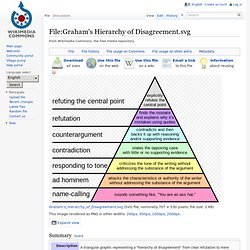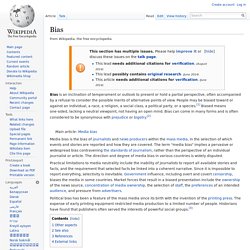

Graham's Hierarchy of Disagreement.svg - Wikipedia, the free encyclopedia. Cancel Edit Delete Preview revert Text of the note (may include Wiki markup) Could not save your note (edit conflict or other problem).

Please copy the text in the edit box below and insert it manually by editing this page. Upon submitting the note will be published multi-licensed under the terms of the CC-BY-SA-3.0 license and of the GFDL, versions 1.2, 1.3, or any later version. See our terms of use for more details. Add a note Draw a rectangle onto the image above (press the left mouse button, then drag and release). Save To modify annotations, your browser needs to have the XMLHttpRequest object. [[MediaWiki talk:Gadget-ImageAnnotator.js|Adding image note]]$1 [[MediaWiki talk:Gadget-ImageAnnotator.js|Changing image note]]$1 [[MediaWiki talk:Gadget-ImageAnnotator.js|Removing image note]]$1. How to Disagree. March 2008 The web is turning writing into a conversation.

Twenty years ago, writers wrote and readers read. The web lets readers respond, and increasingly they do—in comment threads, on forums, and in their own blog posts. Many who respond to something disagree with it. That's to be expected. The result is there's a lot more disagreeing going on, especially measured by the word. If we're all going to be disagreeing more, we should be careful to do it well. DH0. This is the lowest form of disagreement, and probably also the most common. U r a fag!!!!!!!!!! But it's important to realize that more articulate name-calling has just as little weight. Logic.
Logic (from the Ancient Greek: λογική, logike)[1] is the branch of philosophy concerned with the use and study of valid reasoning.[2][3] The study of logic also features prominently in mathematics and computer science.

Logic is often divided into three parts: inductive reasoning, abductive reasoning, and deductive reasoning. The study of logic[edit] The concept of logical form is central to logic, it being held that the validity of an argument is determined by its logical form, not by its content. Traditional Aristotelian syllogistic logic and modern symbolic logic are examples of formal logics. List of fallacies.
Formal fallacy. In philosophy, a formal fallacy (also called logical fallacy) is a pattern of reasoning rendered invalid by a flaw in its logical structure that can neatly be expressed in a standard logic system, for example propositional logic.[1] An argument that is formally fallacious is always considered wrong.

A formal fallacy is contrasted with an informal fallacy, which may have a valid logical form and yet be unsound because one or more premises are false. The presence of a formal fallacy in a deductive argument does not imply anything about the argument's premises or its conclusion. Both may actually be true, or even more probable as a result of the argument, but the deductive argument is still invalid because the conclusion does not follow from the premises in the manner described. "Fallacious arguments usually have the deceptive appearance of being good arguments. Argumentation theory provides a different approach to understanding and classifying fallacies. If P then QPTherefore Q Notes. Informal logic. Informal logic is associated with (informal) fallacies, critical thinking, the Thinking Skills Movement[6] and the interdisciplinary inquiry known as argumentation theory.

Bias. Bias is an inclination of temperament or outlook to present or hold a partial perspective, often accompanied by a refusal to consider the possible merits of alternative points of view.

People may be biased toward or against an individual, a race, a religion, a social class, a political party, or a species.[1] Biased means one-sided, lacking a neutral viewpoint, not having an open mind. Bias can come in many forms and is often considered to be synonymous with prejudice or bigotry.[2] Media bias is the bias of journalists and news producers within the mass media, in the selection of which events and stories are reported and how they are covered. The term "media bias" implies a pervasive or widespread bias contravening the standards of journalism, rather than the perspective of an individual journalist or article. The direction and degree of media bias in various countries is widely disputed. Cognitive bias. List of cognitive biases. Systematic patterns of deviation from norm or rationality in judgment Cognitive biases are systematic patterns of deviation from norm and/or rationality in judgment.
They are often studied in psychology, sociology and behavioral economics.[1] Although the reality of most of these biases is confirmed by reproducible research,[2][3] there are often controversies about how to classify these biases or how to explain them.[4] Several theoretical causes are known for some cognitive biases, which provides a classification of biases by their common generative mechanism (such as noisy information-processing[5]). Gerd Gigerenzer has criticized the framing of cognitive biases as errors in judgment, and favors interpreting them as arising from rational deviations from logical thought.[6] Explanations include information-processing rules (i.e., mental shortcuts), called heuristics, that the brain uses to produce decisions or judgments.
Belief, decision-making and behavioral[edit]